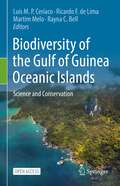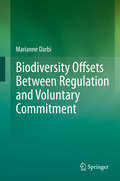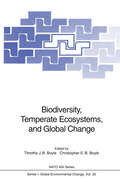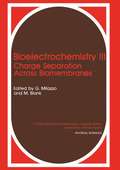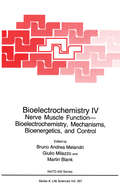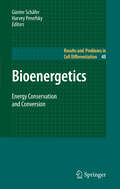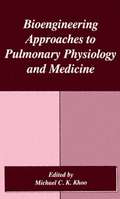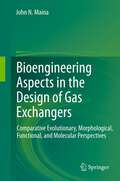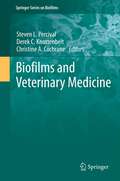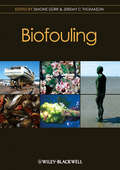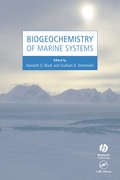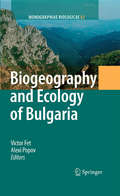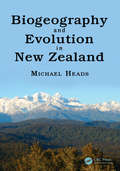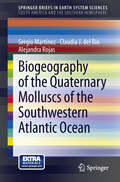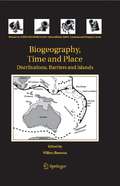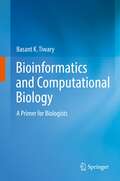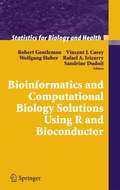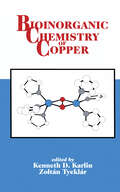- Table View
- List View
Biodiversity of the Gulf of Guinea Oceanic Islands: Science and Conservation
by Luis M. P. Ceríaco Ricardo F. de Lima Martim Melo Rayna C. BellThis open access book presents a comprehensive synthesis of the biodiversity of the oceanic islands of the Gulf of Guinea, a biodiversity hotspot off the west coast of Central Africa. Written by experts, the book compiles data from a plethora of sources – archives, museums, bibliography, official reports and previously unpublished data – to provide readers with the most updated information about the biological richness of these islands and the conservation issues they face. The Gulf of Guinea Oceanic Islands (Príncipe, São Tomé and Annobón and surrounding islets) present extraordinary levels of endemism across different animal, fungi and plant groups. This very high endemism likely results from the long geological history of the islands and their proximity to the diversity-rich continent. Many researchers, students and conservationists from across the globe are interested in documenting biodiversity on the islands, understanding the evolutionary origins of this diversity, and mitigating the impacts of global change on this unique archipelago. This book aims to be a primer for a broad audience seeking baseline biodiversity information and to serve as a roadmap for future research efforts aiming to fill knowledge gaps in understanding and conserving the unparalleled biodiversity of the Gulf of Guinea islands.
Biodiversity Offsets Between Regulation and Voluntary Commitment: A Typology of Approaches Towards Environmental Compensation and No Net Loss of Biodiversity
by Marianne DarbiWe are witnessing an alarming, global biodiversity crisis with an ongoing loss of species and their habitats. In response, a number of tools and approaches – including some that are contested – are being explored and promoted. Biodiversity offsets are one such approach, and deserve critical examination since the debate surrounding them has often been oversimplified and lacking practical evidence. As such, this study presents a refined typology including seven types of biodiversity offsets and taking into account different contexts, governance arrangements and drivers. It draws on a detailed analysis of theoretical concepts to explain the voluntary implementation of biodiversity offsets using an internet-based (netnographic) research approach. Furthermore it builds on a broad global explorative base of 72 practical examples and presents in-depth case studies for each type. The results reveal a number of global tendencies that allow recommendations to be made for different locations, contexts and stakeholders. They also encourage the expansion of this research field to respond to the pressing needs of policy and practice.
Biodiversity, Temperate Ecosystems, and Global Change (Nato ASI Subseries I: #20)
by Timothy J. B. Boyle Christopher E. B. BoyleReviewed here is the current state of knowledge concerning the relationship between global change and biodiversity of temperate ecosystems. The aim is to improve the ability to conserve biodiversity under conditions of global change.The book focuses on:- The threats posed by global change to biodiversity in temperate ecosystems; - Levels and spatial patterns of diversity in temperate ecosystems; - The impact of global change on genetic diversity; - The effects of disturbance (natural and anthropogenic) on temperate ecosystems; - Existing research priorities and programmes.
Biodynamic Beekeeping: A Sustainable Way to Keep Happy, Healthy Bees
by Matthias ThunModern beekeeping, influenced by new technologies and breeding methods, has increased honey production but left bee colonies weak and vulnerable to disease. With the alarming decline of the bee population raising concerns about an impending ecological crisis, many beekeepers are seeking a more sustainable way of caring for bees.Biodynamic Beekeeping is the first book to offer practical instruction on caring for bees using biodynamic theories and methods. By considering the influence of the movement of the stars and the planets on the bees' natural habits, biodynamics encourages beekeepers to be more in tune with their bees indicating, for example, the best days on which to inspect colonies or gather honey.This fascinating book offers beekeepers detailed advice and instruction on how to work more holistically, including:the challenges and advantages of breeding queen beeshow to artificially induce swarming to propagae colonieshow to use biodynamic ashing techniques to combat varroa mitesinstructions for making winter-feed according to current biodynamic thinking
Biodynamics: Circulation
by Y. C. FungThis book is a continuation ofmy Biomechanics.The first volume deals with the mechanical properties of living tissues. The present volume deals with the mechanics ofcirculation. A third volume willdeal with respiration, fluid balance, locomotion, growth, and strength. This volume is called Bio dynamics in order to distinguish it from the first volume. The same style is followed. My objective is to present the mechanical aspects ofphysiology in precise terms ofmechanics so that the subject can become as lucid as physics. The motivation of writing this series of books is, as I have said in the preface to the first volume, to bring biomechanics to students ofbioengineer ing, physiology, medicine, and mechanics. I have long felt a need for a set of books that willinform the students ofthe physiological and medical applica tions ofbiomechanics,and at the same time develop their training in mechan ics. In writing these books I have assumed that the reader already has some basic training in mechanics, to a level about equivalent to the first seven chapters of my First Course in Continuum Mechanics (Prentice Hall, 1977). The subject is then presented from the point of view of life science while mechanics is developed through a sequence of problems and examples. The main text reads like physiology, while the exercises are planned like a mechanics textbook.The instructor may filla dual role :teaching an essential branch of life science, and gradually developing the student's knowledge in mechanics.
Bioelectrochemistry III: Charge Separation Across Biomembranes (Ettore Majorana International Science Series #51)
by Martin Blank Giulio MilazzoThis book contains aseries of review papers related to the lectures given at the Third Course on Bioelectrochemistry held at Erice in November 1988, in the framework of the International School of Biophysics. The topics covered by this course, "Charge Separation Across Biomembranes, " deal with the electrochemical aspects of some basic phenomena in biological systems, such as transport of ions, ATP synthesis, formation and maintenance of ionic and protonic gradients. In the first part of the course some preliminary lectures introduce the students to the most basic phenomena and technical aspects of membrane bioelectrochemistry. The remaining part of the course is devoted to the description of a selected group of membrane-enzyme systems, capable of promoting, or exploiting, the processes of separation of electrically charged entities (electrons or ions) across the membrane barrier. These systems are systematically discussed both from a structural and functional point of view. The effort of the many distinguished lecturers who contributed to the course is aimed at offering a unifying treatement of the electrogenic systems operating in biological membranes, underlying the fundamental differences in the molecular mechanisms of charge translocation.
Bioelectrochemistry IV: Nerve Muscle Function— Bioelectrochemistry, Mechanisms, Bioenergetics, and Control (Nato Science Series A: #267)
by Bruno Andrea Melandri Giulio Milazzo Martin Blankby G. MILAZZO and M. BLANK This book contains the lectures of the fourth advanced course Bioelectrochemislry W Neroe-Muscle Function: Bioelectrochemistry, Mechanisms, Energetics and Contro~ which took place at the Majorana Center in Erice, Italy, October 20th to November 1, 1991. The scope of the course was international in terms of both sponsorship and partici pation. Sponsors included the Bioelectrochemical Society, NATO, International Union of Pure and Applied Biophysics (lUPAB), the World Federation of Scientists and the Italian National Research Council. One-third of the sixty participants were from Italy, but the majority came from eighteen other nations. Since the course was part of the International School of Biophysics, the biophysi cal point of view was emphasized in integrating the biology with the electrochemistry. Lecturers were asked to use a quantitative approach with accepted standards and proper units, since this is absolutely essential for developing an effective common language for communication across disciplines. Participants were also urged not to forget that biological systems could also be considered as physical systems. Ion channels are proteins and their properties as polyelectrolytes contribute to the specific biological properties. The existence of families of channels, with very similar structures but different selectivities, suggests that the specificities arise from slight variations of a general basic design. These perspectives on nerve-muscle function helped to make the school course a unique treatment of the subject.
Bioenergetics: Energy Conservation and Conversion (Results and Problems in Cell Differentiation #45)
by Günter Schäfer Harvey PenefskyThe fermentation of sugar by cell-free yeast extracts was demonstrated more than a century ago by E. Buchner (Nobel Prize 1907). Buchner’s observations put an end to previous animistic theories regarding cellular life. It became clear that metabolism and all cellular functions should be accessible to explication in chemical terms. Equally important for an understanding of living systems was the concept, explained in physical terms, that all living things could be cons- ered as energy converters [E. Schrödinger (Nobel Prize 1933)] which generate complexity at the expense of an increase in entropy in their environment. Bioenergetics was established as an essential branch of the biochemical sciences by the investigations into the chemistry of photosynthesis in i- lated plant organelles [O. Warburg (Nobel Prize 1931)] and by the discovery that mitochondria were the morphological equivalent that catalyzed cellular respiration. The ?eld of bioenergetics also encompasses a large variety of ad- tional processes such as the molecular mechanisms of muscle contraction, the structure and driving mechanisms of microbial ?agellar motors, the energetics of solute transport, the extrusion of macromolecules across membranes, the transformation of quanta of light into visual information and the maintenance of complex synaptic communications. There are many other examples which, in most cases, may perform secondary energy transformations, utilizing - ergy stored either in the cellular ATP pool or in electrochemical membrane potentials.
Bioengineering Approaches to Pulmonary Physiology and Medicine
by Michael C. K. KhooAs the current millennium steams towards a close, one cannot help but look with amazement at the incredible amount of progress that has been achieved in medicine in just the last few decades. A key contributing factor to this success has been the importation and blending of ideas and techniques from disciplines outside the traditional borders of medical science. In recent years, the most well-known example is the cross-pollination between molecular biology and medicine. Advances driven by this potent combination have spawned the vision of a future where cures based on gene therapy become commonplace. Yet, as we continue our search for "magic bullets" in the quest to eradicate disease, it important to recognize the value of other less-heralded interdisciplinary efforts that have laid a large part of the foundation of present-day medicine. In pulmonary medicine, the contribution from the bioengineers (a diverse collection of individuals cross-bred to various degrees in mathematical modeling and experimental physiology) has been larger and more sustained than in many other medical specialties. It is easy to point to the vast array of ventilators, blood-gas analyzers, oximeters, pulmonary function devices, and respiration monitors that are present in any modern clinical setting as solid evidence of the successful synergy between engineering science and pulmonary medicine. However, one must not forget the less tangible, but perhaps more important, contributions that have been derived from mathematical modeling and computer simulation, without which many of these modern instruments would not have come into existence.
Bioengineering Aspects in the Design of Gas Exchangers: Comparative Evolutionary, Morphological, Functional, and Molecular Perspectives
by John N. MainaThis book encapsulates over three decades of the author’s work on comparative functional respiratory morphology. It provides insights into the mechanism(s) by which respiratory means and processes originated and advanced to their modern states. Pertinent cross-disciplinary details and facts have been integrated and reexamined in order to arrive at more robust answers to questions regarding the basis of the functional designs of gas exchangers. The utilization of oxygen for energy production is an ancient process, the development and progression of which were underpinned by dynamic events in the biological, physical, and chemical worlds. Many books that have broached the subject of comparative functional respiratory biology have only described the form and function of the ‘end-product,’ the gas exchanger; they have scarcely delved into the factors and the conditions that motivated and steered the development from primeval to modern respiratory means and processes. This book addresses and answers broad questions concerning the critical synthesis of multidisciplinary data, and clarifies previously cryptic aspects of comparative respiratory biology.
Biofilms and Veterinary Medicine (Springer Series on Biofilms #6)
by Steven Percival, Derek Knottenbelt and Christine CochraneBiofilms are implicated in many common medical problems including urinary tract infections, catheter infections, middle-ear infections, dental plaque, gingivitis, and some less common but more lethal processes such as endocarditis and infections in cystic fibrosis. However, the true importance of biofilms in the overall process of disease pathogenesis has only recently been recognized. Bacterial biofilms are one of the fundamental reasons for incipient wound healing failure in that they may impair natural cutaneous wound healing and reduce topical antimicrobial efficiency in infected skin wounds. Their existence explains many of the enigmas of microbial infection and a better grasp of the process may well serve to establish a different approach to infection control and management. Biofilms and their associated complications have been found to be involved in up to 80% of all infections. A large number of studies targeted at the bacterial biofilms have been conducted, and many of them are referred to in this book, which is the first of its kind. These clinical observations emphasize the importance of biofilm formation to both superficial and systemic infections, and the inability of current antimicrobial therapies to ‘cure’ the resulting diseases even when the in vitro tests suggest that they should be fully effective.In veterinary medicine the concept of biofilms and their role in the pathogenesis of disease has lagged seriously behind that in human medicine. This is all the more extraordinary when one considers that much of the research has been carried out using veterinary species in experimental situations. The clinical features of biofilms in human medicine is certainly mimicked in the veterinary species but there is an inherent and highly regrettable indifference to the failure of antimicrobial therapy in many veterinary disease situations, and this is probably at its most retrograde in veterinary wound management. Biofilms and Veterinary Medicine is specifically focused on discussing the concerns of biofilms to health and disease in animals and provides a definitive text for veterinary practitioners, medical and veterinary students, and researchers.
Biofouling
by Simone Dürr Jeremy C. ThomasonBiofouling (the colonisation of an interface by a diverse array of organisms) is almost always a problem where it occurs, as it negatively affects surfaces, the materials that they are made from and the structures that they form, and can even destroy them. This comprehensive book covers in detail in its first section the processes involved in marine , freshwater and medical biofouling including coverage of settlement by larvae and spores, biofouling community processes, epibiosis (biofouling on living organisms) and microbial fouling, including biofilms deleterious to human health. The book's second section, encompassing biofouling processes with industrial implications, includes coverage of biofouling on artificial substrata, paints and coatings technology for the control of marine biofouling, biofouling and antifouling in the maritime industries, such as shipping, offshore oil , and aquaculture, and in power stations and other industries. The impacts of both biofouling and biofouling control and details of current legislation of relevance to biofouling issues are fully covered. The book's final section looks at methods for the measurement of biofouling, and future prospects for biofouling, including in-depth coverage of the changes anticipated in biofouling worldwide due to global climate change, and likely future directions in antifouling research, technology and legislation. Biofouling, which includes contributions from many international experts, is an essential reference for all those working in the antifouling industry including those involved in formulation of antifouling products such as paints and other coatings. Aquatic biologists, ecologists, environmental scientists and lawyers, marine engineers, aquaculture personnel, chemists, and medical researchers will all find much of interest within this book. All universities and research establishments where these subjects are studied and taught should have copies of this important work on their shelves.
Biogenic Trace Gases: Measuring Emissions from Soil and Water
by P. A. Matson R. C. HarrissTrace gases are those that are present in the atmosphere at relatively low concentrations. Small changes in their concentrations can have profound implications for major atmospheric fluxes, and thereore, can be used as indicators in studies of global change, global biogeochemical cycling and global warming. This new how-to guide will detail the concepts and techniques involved in the detection and measurement of trace gases, and the impact they have on ecological studies. Introductory chapters look at the role of trace gases in global cycles, while later chapters go on to consider techniques for the measurement of gases in various environments and at a range of scales. A how-to guide for measuring atmospheric trace gases. Techniques described are of value in addressing current concerns over global climate change.
Biogeochemistry of Marine Systems (Biological Sciences Series)
by Kenneth D. Black Graham B. ShimmieldMarine systems vary in their sensitivities to perturbation. Perturbation may be insidious – such as increasing eutrophication of coastal areas – or it may be dramatic – such as a response to an oil spillage or some other accident. Climate change may occur incrementally or it may be abrupt, and ecosystem resilience is likely to be a complex function of the interactions of those assemblages or species mediating key biogeochemical processes. Biogeochemistry of Marine Systems considers issues of marine system resilience, focusing on a range of marine systems that exemplify major global province types but are also interesting and topical in their own right, on account of their sensitivity to natural or anthropogenic change or their importance as ecological service providers. Authors concentrate on advances of the last decade.
Biogeography and Ecology of Bulgaria (Monographiae Biologicae #82)
by Victor Fet Alexi PopovFrom single-celled organisms in Black Sea sand to endemic cave crustaceans, from mountain glacial relict insects to the most diverse bird fauna in Europe, the fauna of Bulgaria has been a subject of study for more than a century. This is the first English language survey of all vertebrate and many key invertebrate groups of Bulgaria, their faunistics, origin, geographical and ecological distribution, and conservation issues.
Biogeography and Ecology of Turkmenistan (Monographiae Biologicae #72)
by V. Fet Khabibulla Atamuradovremnants of gene pools of these species. Badghyz Natural Reserve, established in 1941, became a refuge for the last existing population of the Turkmen onager (Equus hemionus onager) and a unique pistachio woodland. A new generation oflocal Turkmen scientists, many of whom were trained by the Russian researchers in the graduate schools of Moscow and Leningrad arose from the 1930s through the 1950s. The Turkmen Academy of Sciences and its journal, Proceedings (including the monthly biological series), served to record the results of diverse biological studies in the republic. While basic science in the Middle Asian republics rather gained from the Russian "colonial" influence, natural resources, in contrast, were severely damaged by the Soviet way of handling the economy and social issues. Severe environmental problems have been inherited by the now independent Turkmenistan, including overgrazed desert pastures, deforested mountains, depleted water resources, accumulated pesticides in cotton fields, declining populations of endangered species of animals and plants, and - worst of al- progressing, human-caused desertification (Kharin this volume). In order to approach a solution to these problems, scientists and officials in the republic will need the close attention and help of the international scientific community.
Biogeography and Evolution in New Zealand (CRC Biogeography Series)
by Michael HeadsBiogeography and Evolution in New Zealand provides the first in-depth treatment of the biogeography of New Zealand, a region that has been a place of long-enduring interest to ecologists, evolutionary scientists, geographers, geologists, and scientists in related disciplines. It serves as a key addition to the contemporary discussion on regionalization—how is New Zealand different from the rest of the world? With what other areas does it share its geology, history, and biota? Do new molecular phylogenies show that New Zealand may be seen as a biological ‘parallel universe’ within global evolution?
Biogeography and Evolution in New Zealand (CRC Biogeography Series #1)
by Michael HeadsBiogeography and Evolution in New Zealand provides the first in-depth treatment of the biogeography of New Zealand, a region that has been a place of long-enduring interest to ecologists, evolutionary scientists, geographers, geologists, and scientists in related disciplines. It serves as a key addition to the contemporary discussion on regionalization—how is New Zealand different from the rest of the world? With what other areas does it share its geology, history, and biota? Do new molecular phylogenies show that New Zealand may be seen as a biological ‘parallel universe’ within global evolution?
Biogeography and Taxonomy of Honeybees
by Friedrich RuttnerHoneybees are as small as flies or as large as hornets, nesting in nar row cavities of trees and rocks or in the open on large limbs of trees 30 m above ground. They occur in tropical zones and in the forests of the Ural mountains, they survive seven months of winter and even longer periods of drought and heat. Historically, they lived through a extended time of stagnation in the tropics from the mid-Tertiary, but then experienced an explosive evolution during the Pleistocene, re sulting in the conquest of huge new territories and the origin of two dozen subspecies in Apis mellifera. This vast geographic and ecologic diversification of the genus Apis was accompanied by a rich morphological variation, less on the level of species than at the lowest rank, the subspecies level. Variation being exclusively of a quantitative kind at this first step of speciation, tradi tional descriptive methods of systematics proved to be unsatisfactory, and honeybee taxonomy finally ended up in a confusing multitude of inadequately described units. Effective methods of morphometric-sta tistical analysis of honeybee popUlations, centered on limited areas, have been developed during the last decades. Only the numerical characterization of the populations, together with the description of behavior, shows the true geographic variability and will end current generalizations and convenient stereotypes.
Biogeography of the Quaternary Molluscs of the Southwestern Atlantic Ocean (SpringerBriefs in Earth System Sciences)
by Sergio Martínez Claudia J. del Río Alejandra RojasThe Quaternary comprises a brief time in the Earth’s history, and apart from a few exceptions, molluscan assemblages recovered from exposures along the coast of Southwestern South America (Southern Brazil, Uruguay, Argentina) are essentially the same than those that inhabit the region today, leading to the assumption that no important change in the distribution of the faunas since Pleistocene times has occurred. However, the good taxonomic and temporal resolution reached in the last years, allowed us to detect some biogeographic changes, although traditional biogeographic units remain the same (i.e. Magellanic and Argentinean Provinces). These modifications involve mainly variations in the taxonomic composition of the assemblages and in the southern boundaries of some species distributions (extralimital species), today retracted northwards. These changes are related to southward shifts of the warm waters of the Brazilian Current, correlated with global warm peaks. This phenomenon was more intense in the Late Pleistocene (MIS 5e) and in the Holocene between ca. 6500-3500 14C yr.
Biogeography, Time and Place: Distributions, Barriers and Islands (Topics in Geobiology #29)
by Willem RenemaThis book offers exchanges between the fields of paleontology and zoology as patterns of biodiversity have long attracted the attention of both biologists and paleontologists. It covers the development of isolated island faunas, paleogeography and zoomorphology. The book shows that patterns are not always what they seem if looked at without a spatial or temporal reference.
Bioinformatics and Computational Biology: A Primer for Biologists
by Basant K. TiwaryThis textbook introduces fundamental concepts of bioinformatics and computational biology to the students and researchers in biology, medicine, veterinary science, agriculture, and bioengineering . The respective chapters provide detailed information on biological databases, sequence alignment, molecular evolution, next-generation sequencing, systems biology, and statistical computing using R. The book also presents a case-based discussion on clinical, veterinary, agricultural bioinformatics, and computational bioengineering for application-based learning in the respective fields. Further, it offers readers guidance on reconstructing and analysing biological networks and highlights computational methods used in systems medicine and genome-wide association mapping of diseases. Given its scope, this textbook offers an essential introductory book on bioinformatics and computational biology for undergraduate and graduate students in the life sciences, botany, zoology, physiology, biotechnology, bioinformatics, and genomic science as well as systems biology, bioengineering and the agricultural, and veterinary sciences.
Bioinformatics and Computational Biology Solutions Using R and Bioconductor (Statistics for Biology and Health)
by Robert Gentleman Vincent Carey Wolfgang Huber Rafael Irizarry Sandrine DudoitFull four-color book. Some of the editors created the Bioconductor project and Robert Gentleman is one of the two originators of R. All methods are illustrated with publicly available data, and a major section of the book is devoted to fully worked case studies. Code underlying all of the computations that are shown is made available on a companion website, and readers can reproduce every number, figure, and table on their own computers.
Bioinformatics of Genome Regulation and Structure
by Nikolay Kolchanov Ralf Hofestaedt- The data gathered can be used to solve a wide range of problems - for basic science and applied science
Bioinorganic Chemistry of Copper
by K.D. Karlin Z. TyeklarBioinorganic Chemistry of Copper focuses on the vital role of copper ions in biology, especially as an essential metalloenzyme cofactor. The book is highly interdisciplinary in its approach--the outstanding list of contributors includes coordination chemists, biochemists, biophysicists, and molecular biologists. Chapters are grouped into major areas of research interest in inorganic copper chemistry, spectroscopy, oxygen chemistry, biochemistry, and molecular biology. The book also discusses basic research of great potential importance to pharmaceutical scientists. This book is based on the first Johns Hopkins University Copper Symposium, held in August 1992. Researchers in chemistry, biochemistry, molecular biology, and medicinal chemistry will find it to be an essential reference on its subject.
